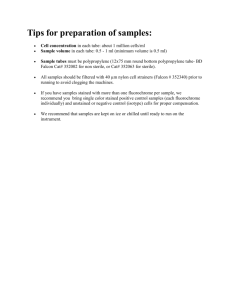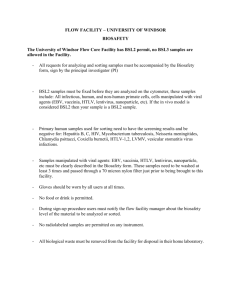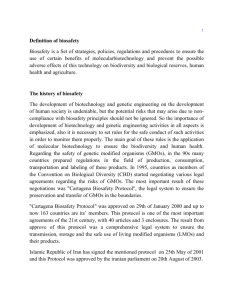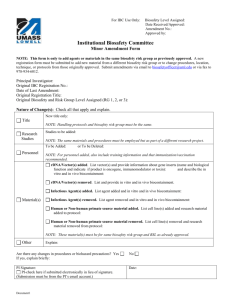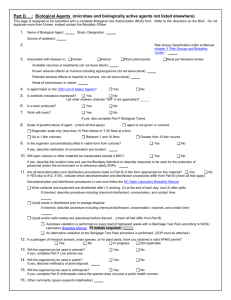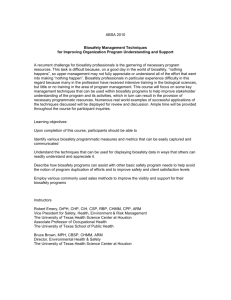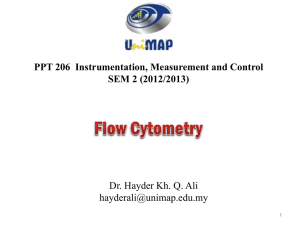FCF sample acquisition form
advertisement
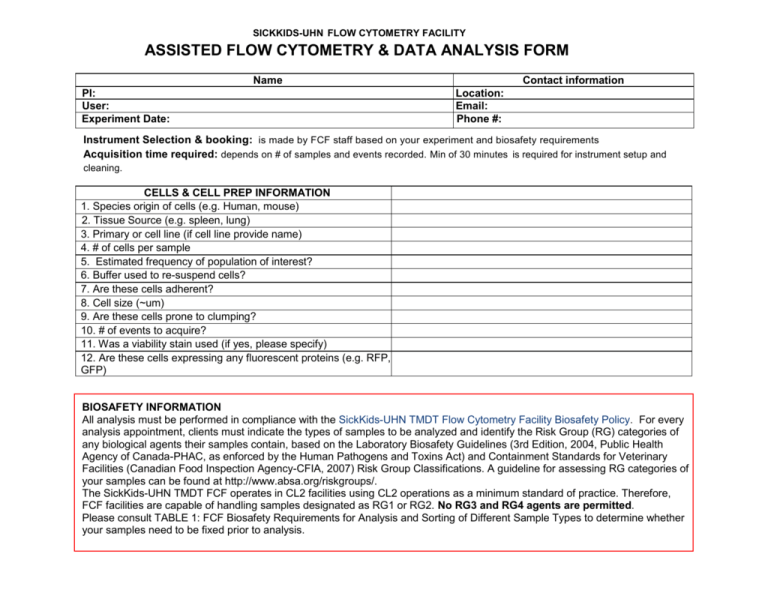
SICKKIDS-UHN FLOW CYTOMETRY FACILITY ASSISTED FLOW CYTOMETRY & DATA ANALYSIS FORM Name PI: User: Experiment Date: Contact information Location: Email: Phone #: Instrument Selection & booking: is made by FCF staff based on your experiment and biosafety requirements Acquisition time required: depends on # of samples and events recorded. Min of 30 minutes is required for instrument setup and cleaning. CELLS & CELL PREP INFORMATION 1. Species origin of cells (e.g. Human, mouse) 2. Tissue Source (e.g. spleen, lung) 3. Primary or cell line (if cell line provide name) 4. # of cells per sample 5. Estimated frequency of population of interest? 6. Buffer used to re-suspend cells? 7. Are these cells adherent? 8. Cell size (~um) 9. Are these cells prone to clumping? 10. # of events to acquire? 11. Was a viability stain used (if yes, please specify) 12. Are these cells expressing any fluorescent proteins (e.g. RFP, GFP) BIOSAFETY INFORMATION All analysis must be performed in compliance with the SickKids-UHN TMDT Flow Cytometry Facility Biosafety Policy. For every analysis appointment, clients must indicate the types of samples to be analyzed and identify the Risk Group (RG) categories of any biological agents their samples contain, based on the Laboratory Biosafety Guidelines (3rd Edition, 2004, Public Health Agency of Canada-PHAC, as enforced by the Human Pathogens and Toxins Act) and Containment Standards for Veterinary Facilities (Canadian Food Inspection Agency-CFIA, 2007) Risk Group Classifications. A guideline for assessing RG categories of your samples can be found at http://www.absa.org/riskgroups/. The SickKids-UHN TMDT FCF operates in CL2 facilities using CL2 operations as a minimum standard of practice. Therefore, FCF facilities are capable of handling samples designated as RG1 or RG2. No RG3 and RG4 agents are permitted. Please consult TABLE 1: FCF Biosafety Requirements for Analysis and Sorting of Different Sample Types to determine whether your samples need to be fixed prior to analysis. 13. Risk Group of samples (RG1,RG2,RG3 or RG4) 14. List any chemical treatments (e.g. PMA, Ionomycin) and associated risk (e.g. carcinogen) 15. List any infectious biological agents cells have been exposed to (e.g. bacteria, retrovirus, EBV) 16. Do cells/biological agents require Level 3 operating procedure as determined by Sickkids/UHN Research Biosafety Committee ? If yes, identify cells/biological agent(s) and Risk Group 17. Have the cells been infected or transfected with any gene transfer vector, and if yes, which one? 18. Are cells fixed? (Yes or No) If yes, list fixative if it’s not the recommended (0.5-2% PFA for at least 30’) SAMPLES MUST BE FILTERED IMMEDIATELY PRIOR TO RUNNING (100uM size filter) FCF can only use 5ml FACS tubes for acquisition. (Corning Inc, cat # 352052, 5ml Polystyrene Round-Bottom tubes) Experiment goal: CONTROLS & EXPERIMENTAL SAMPLES Example CONTROL 1 CONTROL 2 CONTROL 3 CONTROL 4 CONTROL 5 CONTROL X SAMPLE 1 SAMPLE 2 SAMPLE 3 SAMPLE 4 SAMPLE 5 SAMPLE 6 SAMPLE 7 SAMPLE 8 SAMPLE 9 SAMPLE 10 SAMPLE 11 SAMPLE 12 SAMPLE 13 SAMPLE X NAME Marker 1 + Fluorochrome Marker 2 + Fluorochrome Marker 3 + Fluorochrome Marker 4 + Fluorochrome Marker 5 + Fluorochrome Marker 6 + Fluorochrome Viability wtSpleen Untreated pSTAT5 PE pLCK Ax647 CD4 eF450 CD8a PE-Cy TCRab PerCPCy5.5 B220 NC605 DAPI UNSTAINED x x x x x x x EXPERIMENTAL CONTROLS INFORMATION Instrument Setup and Gating Controls: An UNSTAINED CONTROL tube (one for each tissue/cell line) is required for instrument set up. *** YOU MUST BRING THIS CONTROL FOR ANY EXPERIMENT All multicolour assays require SINGLE STAINED CONTROLS for each fluorochrome (cells and/or beads) to calculat e compensation. Viability dye alone control if using viability dye. Fluorescence Minus One (FMO) controls for multicolour assays: used to identify and gate cells in the context of data spread due to the multiple fluorochromes in a given panel. An FMO control contains all the flurochromes in a panel, except for the one that is being measured. Experimental Controls: Dependent on experimental requirements and can include the following: UNTREATED UNSTAINED, UNTREATED STAINED, TREATED UNSTAINED and TREATED STAINED samples. Vector ALONE or UNINFECTED. Positive/negative staining controls. Staining specificity controls: secondary alone. knock-out, siRNA samples
